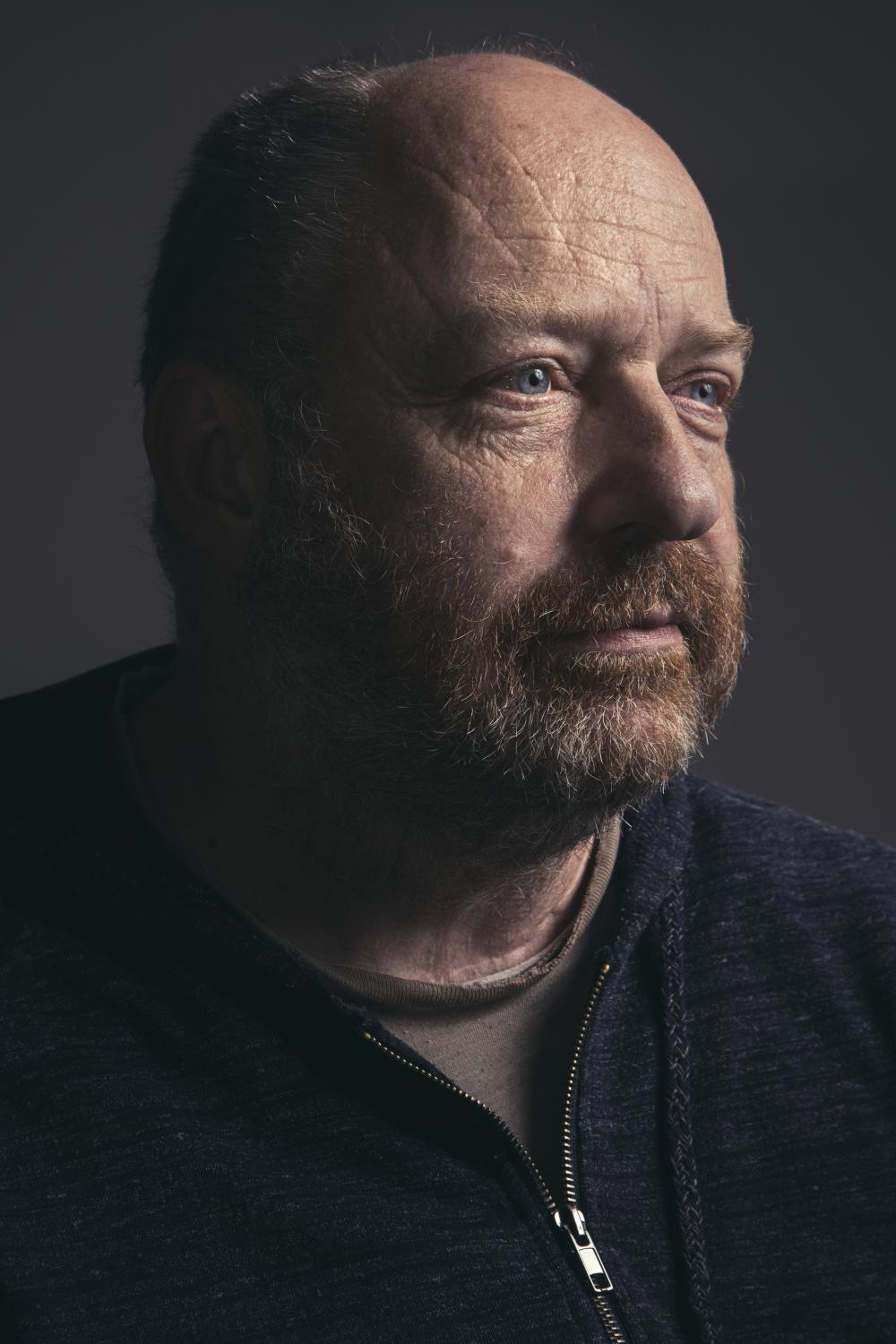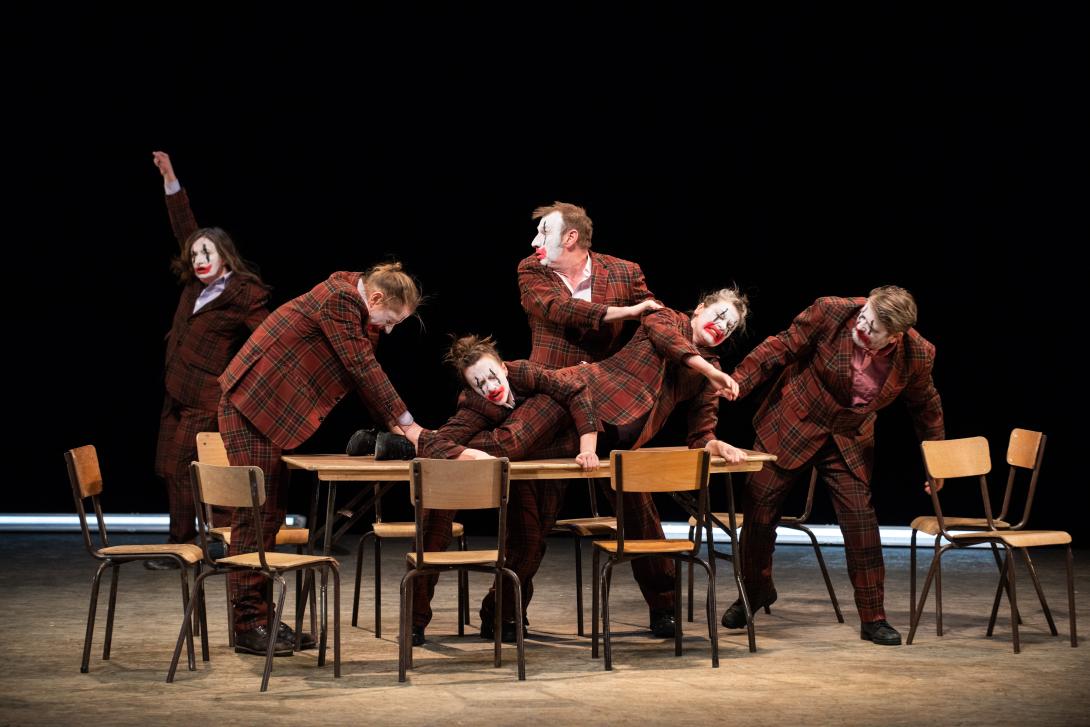We throw you into the deep end, and you have to deal with it.
A conversation with Forced Entertainment
In Out Of Order, the latest show by the British theatre company Forced Entertainment, we see an alley of clowns around a table. Each quiet moment is charged with the next conflictual explosion. Comedy and tragedy go hand in hand in the figure of the clown, but considering these times of political and climatological crises, a clown’s presence onstage is no coincidence, says Tim Etchells, director of Forced Entertainment.
It’s been more than thirty years since Forced Entertainment was founded. How do you maintain the balance between sticking to the core of what Forced Entertainment is versus continuing to reinvent yourself with each piece and evolving with the times?
At its core, Forced Entertainment is an ongoing collaboration between six artists. Over time, we have built up a language, a set of skills and approaches, a collective knowledge, and an understanding. There is a kind of long slow political commitment to that. Our goal is to develop something that is truly collective. But of course right from the beginning, there has always been change: shifts in the aesthetics, and shifts in the way the process works, but also inviting other people to come and work with us or by instigating different kinds of projects. So it is indeed a question of finding a balance between commitment to an ongoing process together and at the same time being open, trying to let the world and our responses to the world change things inside what we do.
When looking at Forced Entertainment from the ongoing perspective, there are several features that keep on recurring, such as repetition itself. Wherein does the strength of this element lie for you?
One way we use repetition is to show a group of people on stage who are so fascinated or obsessed by something, that they want to turn it over again and again. Repetition becomes a way of showing figures on stage who are trying to understand or solve a problem, trying to unstick themselves, to get out of something.
In a funny way of course, these performances are also all about change. They use repetition in order to show change. When things (movements, texts) are repeated in our performances, in fact they change all the time – we’re tuning the audience, focusing attention on differences and shifts.
Does this constant search for solutions also show a fascination for failure?
I think we’re often interested in figures who are failing, who are not finding the glorious easy solution to their problem. They’re stuck with something and trying to find a way out. There is something comedic in failure, in the way people get stuck with material and are not able to escape it. In life we’re all stuck with various things and just because we would like something to change it doesn’t automatically do so. For me there is a fascination in watching people struggle with something, in acknowledging the difficulty of that and the reality of working in a situation where we don’t control everything around us.
Out of order is your first silent theatre show. Real Magic did still have a few words, but they lost all meaning as the piece went on. Now you have gone another step further though.
The decision came out of the rehearsal process, it was not an aim or ambition beforehand. We started making that piece the way we start everything: by trying different materials in the studio. In fact, we started with a lot of text, which tried to explain or mediate the material, but I think we all felt that the text was making the material weaker instead of stronger. Spoken language always pretty much offers a kind of information or explanation. And we liked that there was no information: what is happening is what is happening. It is very private but also super direct. It is what is it. The spoken language was confusing and took the air out of the balloon. And I think at some point I started thinking: this is the one where we will finally get rid of all the spoken language.
In a text you wrote about Out of Order, you call the figures on stage ‘almost clowns’. What do you mean by that?
In our performances, people onstage are often dressed with reference to some kind of theatrical or performance function – they might look like cabaret entertainers, or show dancers, or clowns. But then they never quite do what you’d expect such figures to do – as though they have forgotten their roles or as though they are somehow off duty. In Out of Order a bunch of clowns are sitting around the table and at various points some sort of fight or chase seems to be happening. It could be their clown act. But at the same time, it looks like a fight breaking out in a bar or like a fight in a movie. The clown costumes push it in a playful theatrical direction, but at the same time, we can’t quite be sure. Are the disputes and the fighting real? Is it an act? Are they doing this for fun? Do they really hate each other? How to understand it? Of course it also mirrors the situation we’re often in outside of the theatre: we encounter situations where we don’t understand what is happening, where we’re not sure of the status of what surrounds us.
In that sense, we’ve created a strange situation on the stage in Out of Order. There is something odd happening and as an audience you need to deal with it. You’re pressed into an encounter with the events. It’s uncompromising, it throws you in the deep end – no one is coming to explain everything or to make a joke about how it’s all going to be fine. It’s just there and you have to deal with it. We have to trust the audience that they will find a way to negotiate this.
This piece, like many of the pieces, balances between something that is playful, comical, with a lot humour, and the abyss, the huge hole underneath it. We’re trying to keep the piece in the tension between this comical energy and the sense of a huge hole emotionally and politically. That’s where it wants to be, exactly on that balance point. It’s inherent to the clown figure. It’s in Beckett too, and in Bruce Nauman: there is this fascination with these figures who are there to entertain and to be funny, but who have a relationship with conflict and violence and tragedy. That’s exactly what’s in the air when you put on that make-up.
Out of Order is also an expression used for machines. When they’re ‘out of order’ they don’t function (anymore). Could you read the clowns as dysfunctional clowns, which are not performative and efficient anymore? Rejected by a society that only allows efficiency and perfection?
I think that there are two things there. First of all, we work a lot with figures from popular entertainment, clowns, cabaret or vaudeville or stand up… There is always this interest in what happens when this very efficient machine of entertainment goes wrong or stops functioning. The machinery breaks but some of its devices continue to perform. What do we see then? Of course different things become possible: we understand better what entertainment is in the first place when it starts to break down. We see the violence in it too – the violence of what it is to be a spectator, or what it is to be a performer. We start seeing the people underneath the entertainment in a different way. And poetically speaking, new possibilities start to emerge when things breaks down – because you’ve rearranged the normal functioning of that machine and something else starts to emerge.
The other thing about Out of Order is that it shows a group of people, sitting down around a table as if they might have a meeting or a discussion or a conference. This gathering of a group around a table can be many things. It is no surprise to me that Out of Order or Real Magic are made now, in this moment of Brexit and Trump and Global Warming. This sense that political solutions are in an endless deadlock. Even though everybody knows the correct answer to a question, they still don’t seem to be able organize themselves to make it happen. I think both of those pieces speak to a kind of frustration with the structures that we have. And they are very much about people who are caught in a social and political machinery that doesn’t work properly.
When it comes to questions of entertainment, we also have an interest in the question of where we can take an audience? How much does an audience need of the efficiency of those very tight entertainment machines that are set out in popular culture or mainstream forms. We know that an audience can actually cope with a lot more than people ordinarily suppose - they can be taken to many different places. I think that is what pulled us into making theatre in the first place. Because it’s a place where you can still experiment and play with those questions in order to create a different kind of contact with the audience. That’s our desire. Not just for the sake of breaking that machine. What matters is what kind of space and connection you can open up with audiences. And somehow when you’re breaking that machine, when it’s out of order, the possibilities are greater than when everything is going smoothly.
A conversation with Forced Entertainment’s Tim Etchells, by Eva Decaesstecker (November 2019, Kaaitheater)

